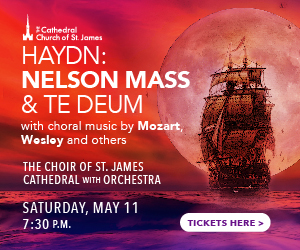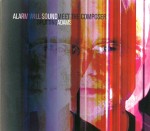 This month’s adventure began with a hybrid, a melding of two honoured institutions in the new music world: WQXR-FM’s Q2 podcast Meet the Composer and New York’s renowned ensemble Alarm Will Sound. The two have come together to produce a CD entitled Splitting Adams (Cantaloupe Music CA21128 cantaloupemusic.com) which presents two works by John Adams – Chamber Symphony and Son of Chamber Symphony – prefaced by extended interviews with the composer, host (and Alarm Will Sound violist) Nadia Sirota, artistic director Alan Pierson and members of the ensemble.
This month’s adventure began with a hybrid, a melding of two honoured institutions in the new music world: WQXR-FM’s Q2 podcast Meet the Composer and New York’s renowned ensemble Alarm Will Sound. The two have come together to produce a CD entitled Splitting Adams (Cantaloupe Music CA21128 cantaloupemusic.com) which presents two works by John Adams – Chamber Symphony and Son of Chamber Symphony – prefaced by extended interviews with the composer, host (and Alarm Will Sound violist) Nadia Sirota, artistic director Alan Pierson and members of the ensemble.
Alarm Will Sound (AWS) was established in 2001. It is a large ensemble comprising the instrumentation required for Arnold Schoenberg’s Chamber Symphony Op.9 (1906), full winds and brass, percussion, piano and string quintet, which Adams also chose for his own foray into the genre in 1992. The podcast discusses the importance of Schoenberg in the history of contemporary music and his move to Los Angeles after the rise of Nazism in his native Austria. Regarding the relationship between Schoenberg’s influential Chamber Symphony and Adams’ own somewhat larger than life and at times parodic work, the composer states “I enjoy that kind of delicious irony of crass American commercialism cheek by jowl with very profound serious European high culture.” The 17-minute documentary is skillfully produced and cleverly edited with audio clips of historical examples and previews, establishing a context for the recorded performance that follows.
Adams’ Son of Chamber Symphony was written specifically for AWS in 2007. The extreme difficulty of the work is explored in the podcast, as are some of the musical references, including the distinctive rhythms of the Scherzo from Beethoven’s Ninth Symphony. The musicians discuss the pit- and pratfalls of having the composer present from the first day of rehearsal. My own experience with New Music Concerts has ingrained in me the importance of the input of the composer, but members of AWS talk of how daunting it is when the composer is there before they have had a chance to familiarize themselves properly with the music. In this instance Adams wanted to conduct the first rehearsal, just a few days after the music had been delivered, and commenced to make changes to the score based on the musicians’ first stumbling attempts with some extreme passages. While one might think this would be a relief to the musicians, in a sense they felt cheated by not having the opportunity to master the more difficult original score. In one instance, with the composer’s permission, in subsequent performances the flutist has reverted to the initial version rather than switching to piccolo for an extremely high passage as suggested in Adams’ revision. Again, from my experience with New Music Concerts I know just how much effort is involved in preparing a new work for performance, especially when faced with the complexity of serious contemporary music. It has been a decade since AWS premiered Son of Chamber Symphony and only now after dozens of performances have they felt comfortable enough with the music to record it for posterity. It is a stunning work, made more memorable by the “Illuminating Introduction” (to borrow a phrase from New Music Concerts) provided in this excellent collaboration. While I will not be listening to the podcast as a preamble each time I put on the disc, I’m very pleased to have been exposed to the insights it provided.
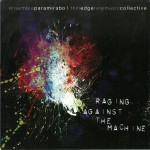 Vancouver’s Redshift Music Society, like Alarm Will Sound, was founded in 2001, with “a focus on bringing the music of contemporary Canadian composers to the general public through unique musical events, mostly in public venues.” In 2007 Redshift Records (redshiftrecords.org) was established and for the past decade has been producing some of the most significant recordings of contemporary music in the country. Two such titles arrived at my desk recently: New Wave (TK448) featuring one of Vancouver’s senior ensembles Standing Wave (founded 1991) and Raging Against the Machine (TK449), a collaborative project between Montreal’s Ensemble Paramirabo (founded 2008) and Toronto’s relative newcomer Thin Edge New Music Collective (founded 2011). Both releases are diverse in their offerings, with New Wave featuring five Canadian works composed (or revised) in past four years and Raging Against the Machine with three recent works by young Canadians bookended by established words by senior international composers.
Vancouver’s Redshift Music Society, like Alarm Will Sound, was founded in 2001, with “a focus on bringing the music of contemporary Canadian composers to the general public through unique musical events, mostly in public venues.” In 2007 Redshift Records (redshiftrecords.org) was established and for the past decade has been producing some of the most significant recordings of contemporary music in the country. Two such titles arrived at my desk recently: New Wave (TK448) featuring one of Vancouver’s senior ensembles Standing Wave (founded 1991) and Raging Against the Machine (TK449), a collaborative project between Montreal’s Ensemble Paramirabo (founded 2008) and Toronto’s relative newcomer Thin Edge New Music Collective (founded 2011). Both releases are diverse in their offerings, with New Wave featuring five Canadian works composed (or revised) in past four years and Raging Against the Machine with three recent works by young Canadians bookended by established words by senior international composers.
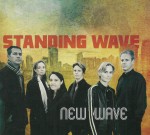 New Wave begins with Nicole Lizée’s Sculptress, a tribute to Delia Derbyshire that incorporates sounds of her pioneering electronic compositions from the ’60s and ’70s with live ensemble performance and modern technology. Marcus Goddard’s Raven Tales is based on the work of Indigenous artist Mike Dangeli, with rhythmic marimba passages and sprightly flute and clarinet melodies giving way to a sombre second movement called Ancestral Voice before returning to a lively and playful finale. Goddard is a composer I had not previously heard of, as are Justin Christensen and Edward Top, who are also represented on this disc. As an aside, I will note here I find it frustrating that although the tripartite cardboard CD case includes program notes by the composers (not a very helpful one in the case of Christensen, I’m afraid) there is no information about the composers, the ensemble or its members. Googling Goddard took me to several long-out-of-date biographies (including one at the Canadian Music Centre) before I found the composer’s own website, and it took four or five searches to confirm that the Dutch-born Siemen Edward Top, sometime composer-in-residence with the Vancouver Symphony it seems, was indeed the Top included here. Michael Oesterle, however, is a composer whose work I have known for almost two decades. The Quebec-based, German-born (1968) composer is among the stronger voices of his generation and his music has been performed in Toronto with some regularity. Emmy Noether pays tribute to the author of Noether’s (first) theorem which states that every differentiable symmetry of the action of a physical system has a corresponding conservation law. The theorem was proven by mathematician Emmy Noether in 1915 and published in 1918. According to Oesterle’s program note this “leant proof to Einstein’s theory of general relativity and remains a cornerstone in the equations of physicists today.” I must confess that I don’t get the correlation between the theory and his composition, but I’m willing to take his word that “symmetry, conservation of energy [and] momentum” play their part. It’s a charming work at any rate with bell-like sounds from the piano and vibraphone overlaid with pointillist flute and motivic string lines.
New Wave begins with Nicole Lizée’s Sculptress, a tribute to Delia Derbyshire that incorporates sounds of her pioneering electronic compositions from the ’60s and ’70s with live ensemble performance and modern technology. Marcus Goddard’s Raven Tales is based on the work of Indigenous artist Mike Dangeli, with rhythmic marimba passages and sprightly flute and clarinet melodies giving way to a sombre second movement called Ancestral Voice before returning to a lively and playful finale. Goddard is a composer I had not previously heard of, as are Justin Christensen and Edward Top, who are also represented on this disc. As an aside, I will note here I find it frustrating that although the tripartite cardboard CD case includes program notes by the composers (not a very helpful one in the case of Christensen, I’m afraid) there is no information about the composers, the ensemble or its members. Googling Goddard took me to several long-out-of-date biographies (including one at the Canadian Music Centre) before I found the composer’s own website, and it took four or five searches to confirm that the Dutch-born Siemen Edward Top, sometime composer-in-residence with the Vancouver Symphony it seems, was indeed the Top included here. Michael Oesterle, however, is a composer whose work I have known for almost two decades. The Quebec-based, German-born (1968) composer is among the stronger voices of his generation and his music has been performed in Toronto with some regularity. Emmy Noether pays tribute to the author of Noether’s (first) theorem which states that every differentiable symmetry of the action of a physical system has a corresponding conservation law. The theorem was proven by mathematician Emmy Noether in 1915 and published in 1918. According to Oesterle’s program note this “leant proof to Einstein’s theory of general relativity and remains a cornerstone in the equations of physicists today.” I must confess that I don’t get the correlation between the theory and his composition, but I’m willing to take his word that “symmetry, conservation of energy [and] momentum” play their part. It’s a charming work at any rate with bell-like sounds from the piano and vibraphone overlaid with pointillist flute and motivic string lines.
Unlike New Wave, Raging Against the Machine comes with a bilingual booklet replete with program notes, composer biographies (although I am tired of being told that Steve Reich is “America’s greatest living composer”) and ensemble blurbs. The recording was made in the Glenn Gould Studio in January 2016, as a follow-up to a cross country tour by Paramirabo and Thin Edge the previous spring. It begins with Reich’s dynamic, if somewhat predictable, Double Sextet (2007), a work which provided the context for the project with its scoring for two ensembles of flute, clarinet, violin, cello, piano and percussion. Patrick Giguère’s Le sel de la terre (2015) was commissioned and is performed by Thin Edge. In his note Giguère explains his identification of the “machine” in the context of the project as consumer-oriented society and dedicates his thoughtful and somewhat lyrical piece to those individuals who choose to rage against it through their life choices. Toronto composer Brian Harman was commissioned to create a work for the double ensemble and he says Hum presents “two different types of materials – machine sounds (from gently undulating to brash) and music associated with human rituals (from harvest songs to intimate shower singing). I am interested in the inherent physicality of these two musical worlds, and finding similarities between them.” The result is mostly contemplative, with occasional ventures into dense textures and a gradual building of intensity, but nothing I would identify as rage. Anna Höstman, also currently based in Toronto, created Fog at the request of Paramirabo with the support of both the Canada and Toronto Arts Councils. “Some of the most beautiful and haunting landscapes are those enshrouded in fog, a natural phenomenon where mystery is made visible.” Her sparse and somewhat blurry landscape is indeed a beauty to behold. The disc ends as it began, in a flurry of activity, with Dutch composer Louis Andriessen’s iconic Workers Union. Once again the forces of both ensembles are employed to realize a work that is scored for “any loud-sounding group of instruments.” While the rhythms are strictly notated, pitches are only approximately specified. Andriessen states that “it is difficult to play in an ensemble and to remain in step, similar to organizing and carrying out political actions.” This is an exuberant performance in which a good time is obviously had by all, in spite of the built-in challenges.
Review
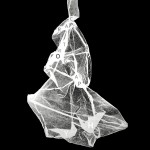 Raging Against the Machine may be the title of the last CD discussed, but the phrase could apply equally, or perhaps even more appropriately, to Eric Wubbels’ composition gretchen am spinnrade which opens Mariel Roberts’ latest CD Cartography (New Focus Recordings fcr185 marielroberts.com). As a matter of fact I had to go online to watch a video of a live performance (at icareifyoulisten.com) to see whether or not any machine-like technology was in use. With the composer at the piano and Roberts on cello it is amazing to realize that the excruciating intensity is being generated in real time by two mere mortals. It is truly a sight, and sound, to behold, with what Wubbels describes as “alternating relentless motoric circuits with plateaus of regular ‘idling’ motion.” After repeated listening and viewing it is still not clear to me whether the microtonality in the piano part as the piece progresses is a result of the frantic banging on the keys, or if some of the notes have been specially (de)tuned in advance. Whatever the case, Gretchen is definitely pictured at a particularly post-industrial spinning wheel in this reinterpretation of Schubert’s original.
Raging Against the Machine may be the title of the last CD discussed, but the phrase could apply equally, or perhaps even more appropriately, to Eric Wubbels’ composition gretchen am spinnrade which opens Mariel Roberts’ latest CD Cartography (New Focus Recordings fcr185 marielroberts.com). As a matter of fact I had to go online to watch a video of a live performance (at icareifyoulisten.com) to see whether or not any machine-like technology was in use. With the composer at the piano and Roberts on cello it is amazing to realize that the excruciating intensity is being generated in real time by two mere mortals. It is truly a sight, and sound, to behold, with what Wubbels describes as “alternating relentless motoric circuits with plateaus of regular ‘idling’ motion.” After repeated listening and viewing it is still not clear to me whether the microtonality in the piano part as the piece progresses is a result of the frantic banging on the keys, or if some of the notes have been specially (de)tuned in advance. Whatever the case, Gretchen is definitely pictured at a particularly post-industrial spinning wheel in this reinterpretation of Schubert’s original.
By way of respite, Aman by Cenk Ergün is a much quieter offering, but one that does involve live electronics by the composer along with Roberts’ solo cello. While it was the intensity and sheer volume of Wubbels’ scoring that made the sounds seem mechanical in gretchen, here it is the sparseness that makes them unfamiliar and somewhat otherworldly. It is as if we are “listening” through a microscope to the very structure of the sounds. It’s often hard to distinguish between the manufactured sounds and those created by extended techniques on the cello. I look forward to seeing a video of this one or, better yet, the chance to see Roberts in live performance.
George Lewis’ Spinner for solo cello veritably bursts forth after the quietude of Aman. Lewis, Edwin H. Case Professor of American Music at Columbia University, is also a renowned trombonist who has worked with the Association for the Advancement of Creative Music for more than four and a half decades. Spinner is set in a more traditional mode for a virtuosic solo instrumental work, at least in the sense of the post-war avant-garde. It is a compendium of sounds available to the cellist using bow and fingers on the strings of the instrument, without venturing into the various extra-musical extensions sometimes called for in the context. It is a thoroughly musical work, which effectively integrates some aspects of modern jazz without compromising its status as a concert piece.
The disc concludes with The Cartography of Time by New York-based composer Davíð Brynjar Franzson. The program note includes a definition of cartography (map-making) and time (the indefinite continued progress of existence…) and a quotation from Wittgenstein, none of which sheds much light on the piece, but I do find its progress glacial and textures reminiscent of an Icelandic landscape or, in my wife’s ears, Northern Lights, perhaps linked to the composer’s birthplace, Akureyri, on the north coast of Iceland just south of the Arctic Circle.
All in all, Roberts’ disc is an incredible journey. Fasten your seatbelt and pack your parka, but be forewarned, although it begins with a bang!, it ends with a whisper…
We welcome your feedback and invite submissions. CDs and comments should be sent to: DISCoveries, WholeNote Media Inc., The Centre for Social Innovation, 503 – 720 Bathurst St. Toronto ON M5S 2R4. We also encourage you to visit our website, thewholenote.com, where you can find enhanced reviews in the Listening Room with audio samples, upcoming performance details and direct links to performers, composers and record labels.
David Olds, DISCoveries Editor
discoveries@thewholenote.com



